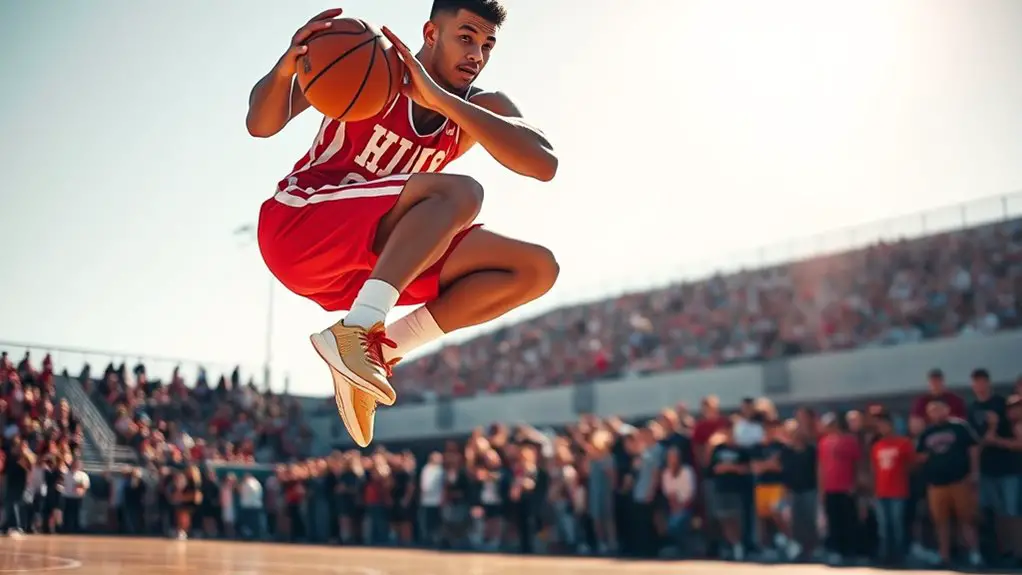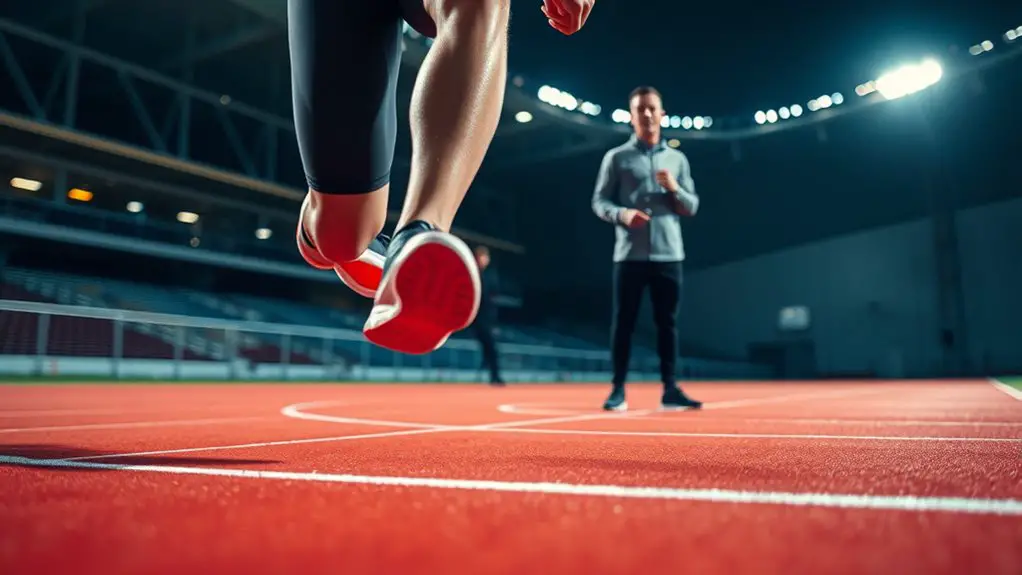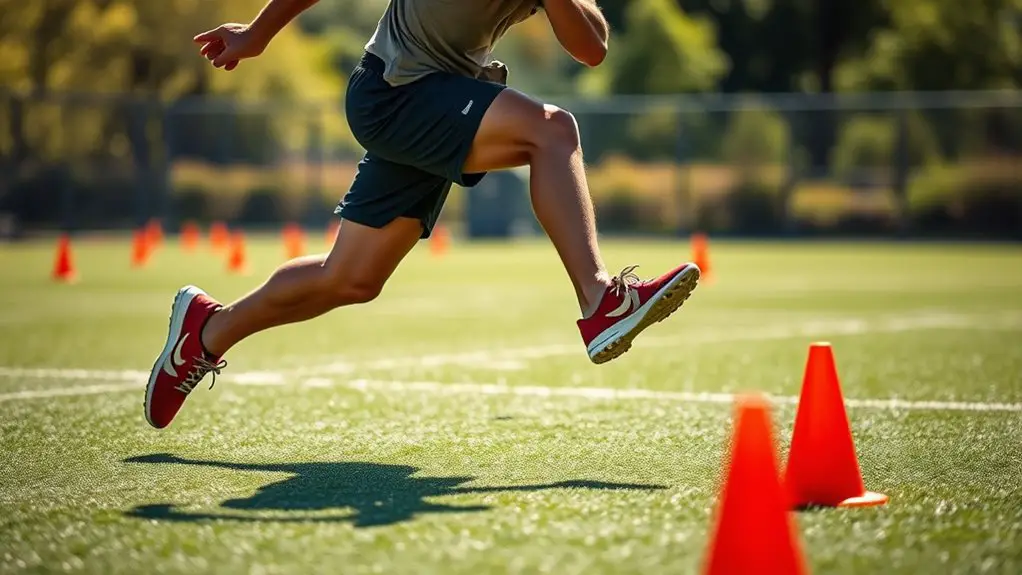To boost your basketball performance, focus on power exercises like plyometrics and Olympic lifts. Incorporate box jumps and depth jumps for explosive power, alongside cleans and snatches to enhance overall strength. Don't forget medicine ball throws to improve your upper body power and rotational throws for core strength. Add speed and agility drills to sharpen your movements. Keep training flexible and recover well to maximize your results. There's more on how to structure your program effectively.
Understanding Power Training for Basketball
When you think about enhancing your game, understanding power training for basketball is essential. Power training focuses on building explosive strength, which can elevate your performance on the court. It's not just about lifting heavy weights; it's about developing the energy and speed you need to make those quick moves and strong plays.
Incorporating power exercises into your routine can help you jump higher, run faster, and react quicker, giving you the edge you crave. Think of exercises like Olympic lifts, medicine ball throws, and kettlebell swings. These movements engage multiple muscle groups and mimic the dynamic nature of basketball. Additionally, incorporating plyometric training can significantly enhance your explosiveness and overall athletic performance.
Plyometric Exercises to Enhance Jumping Ability
If you want to boost your jumping ability, plyometric exercises are a game-changer. Box jumps can improve your explosive power, while mastering depth jumps can enhance your technique and control. Incorporating the stretch-shortening cycle into your training can maximize your muscle potential and elevate your performance on the court.
Box Jumps Benefits
Box jumps are a powerful tool for basketball players looking to boost their vertical leap and explosive strength. Incorporating box jumps into your training routine can lead to significant improvements. Here are some key benefits:
- Increased Power: You'll develop greater explosive strength, essential for jumping and sprinting.
- Improved Coordination: These jumps enhance your body awareness and timing, vital for on-court movements.
- Enhanced Agility: You'll move more fluidly, allowing you to change direction swiftly during gameplay.
- Stronger Legs: Regularly practicing box jumps builds muscle in your quads, hamstrings, and calves, giving you that extra push.
Depth Jumps Technique
Depth jumps are a highly effective plyometric exercise that can greatly enhance your jumping ability on the basketball court. To perform this exercise, start by standing on a sturdy platform about 1-2 feet high. Step off, landing softly with your knees bent to absorb the impact. As soon as you hit the ground, explode upward into a jump, aiming to reach your maximum height. Focus on minimizing ground contact time; the quicker you react, the better. Incorporate depth jumps into your training routine 1-2 times a week, allowing for adequate recovery. Remember to prioritize form over height to avoid injury. With consistent practice, you'll notice improvements in your vertical leap, giving you a competitive edge during games.
Olympic Lifts for Explosive Strength
Olympic lifts, such as the clean and jerk and the snatch, are fundamental for developing explosive strength in basketball players. These lifts enhance your power output, which translates to improved jumping ability and quickness on the court. Here's how you can incorporate them into your training:
- Clean and Jerk: This lift helps build overall body strength and coordination, essential for explosive movements.
- Snatch: Focuses on speed and power, improving your ability to accelerate quickly during gameplay.
- Technique: Proper form is critical; consider working with a coach to avoid injury and maximize effectiveness.
- Progression: Start with lighter weights to master the movement, then gradually increase as you gain confidence and strength. Additionally, developing fast-twitch muscle fibers is vital for achieving explosiveness in your performance.
Medicine Ball Workouts for Core Power
While many athletes focus on upper and lower body strength, core power is equally essential for basketball players. Medicine ball workouts are a fantastic way to build that core strength, giving you the stability and explosiveness you need on the court. Start with basic exercises like medicine ball slams and twists to engage your entire core.
Incorporate rotational throws against a wall to mimic the twisting motions you'll use during gameplay. Don't forget to include overhead throws, which help develop those critical overhead movements needed for shooting and passing.
You can also try partner drills, passing the ball back and forth while maintaining a strong core stance. Each rep builds not just your strength, but your confidence. Remember, a powerful core translates into better balance, agility, and overall performance. Additionally, incorporating squat exercises can further enhance your lower body strength and stability on the court. So grab a medicine ball, and let's get to work!
Speed and Agility Drills to Boost Performance
To elevate your game, incorporating speed and agility drills is essential. Ladder drills can enhance your footwork, while cone drills help improve your acceleration and direction changes. Improving overall agility is crucial for making you quicker on the court.
Ladder Drills for Agility
Ladder drills are a fantastic way to enhance your agility on the court. These drills help you develop quick footwork, improve coordination, and boost your overall performance. Plus, they're fun and can be done almost anywhere! Here are four effective ladder drills you should try:
- In-and-Outs: Step in and out of each rung, alternating feet to build speed.
- Lateral Shuffles: Move sideways down the ladder, keeping your feet light and quick.
- Single-Leg Hops: Jump in each square on one leg, focusing on balance and control.
- Carioca: Move diagonally through the ladder, crossing your feet to enhance lateral movement.
Incorporate these drills into your routine, and watch your agility soar!
Cone Drills for Speed
After honing your agility with ladder drills, it's time to shift your focus to cone drills, which are fantastic for building speed and improving your quickness on the court. Set up cones in various patterns—like a T, zigzag, or box—and sprint between them. These drills force you to accelerate, decelerate, and change direction quickly, simulating game scenarios.
Start with simple patterns, then gradually increase complexity as you get comfortable. Keep your knees high and arms pumping to maximize your speed. You'll not only enhance your sprinting ability but also develop essential reaction time.
Incorporate these cone drills into your routine, and watch your performance soar. Embrace the challenge, and enjoy the freedom of movement on the court!
Resistance Training for Lower Body Strength
Building lower body strength is essential for basketball players who want to enhance their performance on the court. Strong legs not only improve your jumping ability but also help with agility and stability during games. Here are some resistance training exercises you shouldn't skip:
Building lower body strength is crucial for basketball players to boost performance, agility, and stability on the court.
- Squats: These build overall leg strength, targeting your quads, hamstrings, and glutes.
- Deadlifts: Perfect for developing posterior chain strength, which is critical for explosive movements.
- Lunges: They improve balance and coordination while engaging multiple muscle groups.
- Leg Press: A great way to isolate your leg muscles and increase overall power.
Incorporating these exercises into your routine will give you the freedom to move more fluidly on the court, allowing you to outmaneuver opponents and elevate your game. Additionally, focusing on essential muscle groups will further enhance your overall performance. Remember, consistent effort in resistance training translates to better performance when it matters most.
Upper Body Power Exercises for Improved Shooting
While strong legs are essential for basketball, upper body power exercises play an important role in improving your shooting performance. You need explosive strength in your arms, chest, and shoulders to get that perfect shot off quickly and accurately. Incorporate exercises like bench presses and push-ups to build your chest and triceps strength. Medicine ball throws can enhance your explosive power, helping you generate force through your upper body when shooting.
Don't forget about your shoulders; overhead presses and band pull-aparts can increase stability and strength, which are vital for a consistent shooting form. Integrating these exercises into your routine will not only boost your shooting range but also give you the confidence to take those big shots. Remember, a well-rounded training plan is key to releasing your full potential on the court, so make sure to include upper body power work alongside your leg strength training. Additionally, understanding muscle functions can enhance targeted workouts for strength and performance.
Incorporating Flexibility and Mobility Work
Although strength is essential for basketball performance, flexibility and mobility shouldn't be overlooked. These elements are key to enhancing your agility, preventing injuries, and improving overall fluidity on the court. Here are four ways to incorporate flexibility and mobility work into your routine:
- Dynamic Stretching: Start your warm-up with movements that mimic game actions, like leg swings or arm circles, to prepare your muscles for play.
- Static Stretching: After workouts, include static stretches targeting major muscle groups to improve your range of motion and recovery.
- Foam Rolling: Use a foam roller to release tight muscles and enhance blood flow, helping you move more freely.
- Yoga or Pilates: Incorporate these practices weekly to enhance core strength and flexibility, giving you a greater sense of control on the court.
Additionally, regular mobility training can reduce injury risk, allowing you to perform at your best without the fear of setbacks. Embrace these techniques, and you'll feel more liberated in your movements, elevating your game to new heights.
Sample Power Training Program for Basketball Players
To maximize your on-court performance, a structured power training program is essential for basketball players. Start with a dynamic warm-up, focusing on mobility to get your body ready. For strength, include exercises like squats and deadlifts, aiming for 3 sets of 6-8 reps. Add plyometrics like box jumps and depth jumps to build explosive power; 3 sets of 5 reps will do the trick. Incorporate Olympic lifts, such as the clean and jerk, for overall strength—3 sets of 3-5 reps should suffice.
Additionally, including calf raises in your routine can further enhance your jumping ability and overall stability. Don't forget to work on your core with movements like medicine ball slams and rotational throws, which enhance stability and power transfer. Finally, finish with a cool-down, including static stretching to maintain flexibility. Make sure to listen to your body and adjust the intensity based on your energy levels. This program will not only boost your power but also make you a more dynamic player on the court.
Frequently Asked Questions
How Often Should Basketball Players Perform Power Exercises?
You should perform power exercises about two to three times a week. This frequency helps build strength without overtraining, allowing you to enhance your performance while keeping your body fresh and ready for action.
What Is the Best Warm-Up Routine Before Power Training?
Before diving into power training, think of your body as a finely-tuned engine. Start with dynamic stretches, some light jogging, and mobility drills to ignite your muscles, ensuring you're free to release your full potential.
Are There Any Specific Nutrition Tips for Power Training?
For power training, focus on high-quality proteins and complex carbs to fuel your workouts. Don't forget to stay hydrated and consider timing your meals around training sessions for peak energy and recovery benefits.
How Can I Track My Progress in Power Training?
Tracking your progress in power training can boost motivation. Did you know that athletes who document their workouts see a 25% improvement? Use apps, journals, or even video to monitor your gains and stay inspired.
What Common Mistakes Should I Avoid in Power Training?
In power training, avoid rushing through exercises, neglecting warm-ups, and skipping proper form. Don't ignore rest days or underestimate nutrition; your body needs time and fuel to recover and grow stronger. Listen to it!




